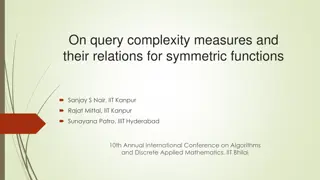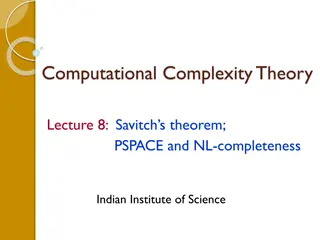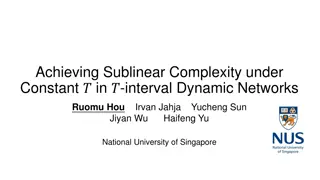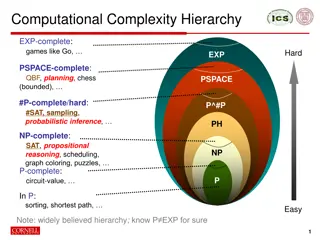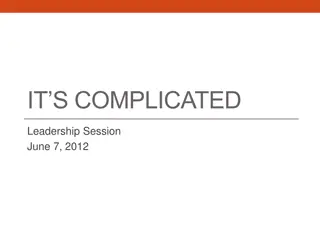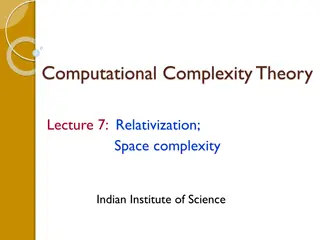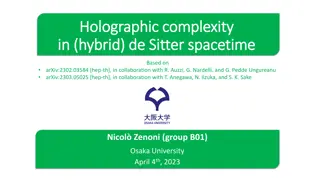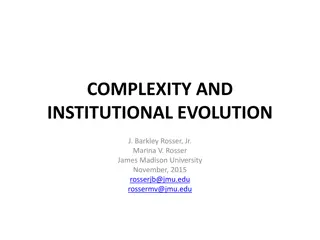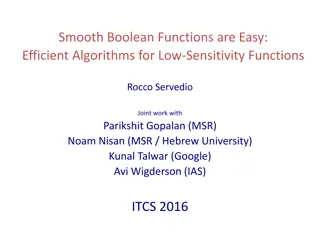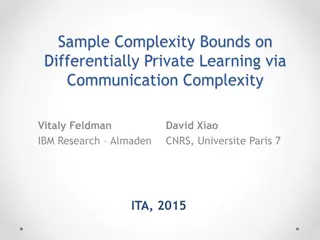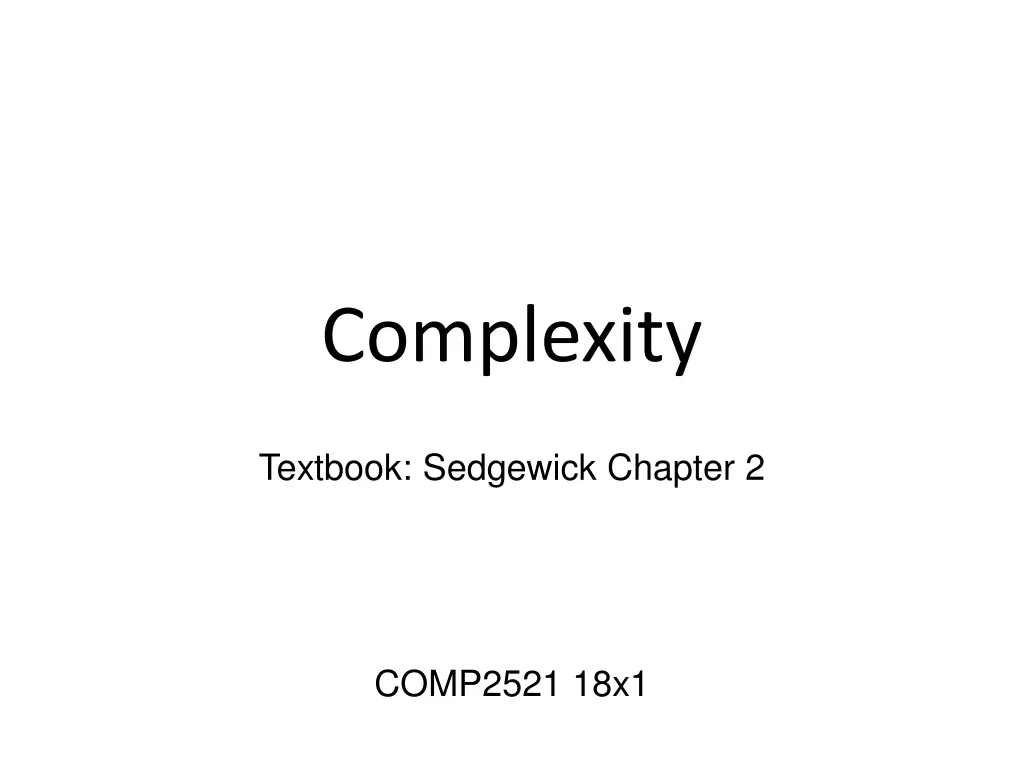
Understanding Algorithm Efficiency in Software Development
Explore the importance of algorithm efficiency in software development, covering topics such as problems, algorithms, programs, and processes. Learn how to analyze software quality and determine algorithm efficiency through examples from complexity theory.
Download Presentation

Please find below an Image/Link to download the presentation.
The content on the website is provided AS IS for your information and personal use only. It may not be sold, licensed, or shared on other websites without obtaining consent from the author. If you encounter any issues during the download, it is possible that the publisher has removed the file from their server.
You are allowed to download the files provided on this website for personal or commercial use, subject to the condition that they are used lawfully. All files are the property of their respective owners.
The content on the website is provided AS IS for your information and personal use only. It may not be sold, licensed, or shared on other websites without obtaining consent from the author.
E N D
Presentation Transcript
Complexity Textbook: Sedgewick Chapter 2 COMP2521 18x1
Problems, Algorithms, Programs and Processes Problem: A problem that needs to be solved Algorithm: Well defined instructions for completing the problem Program: Implementation of the algorithm in a particular programming language Process: An instance of the program as it is being executed on a particular machine
Analysis of software What makes software "good"? returns expected result for all valid inputs behaves "sensibly" for non-valid inputs clear code, easy to maintain/modify interface is clear and consistent (API or GUI) returns results quickly (even for large inputs) Ie Ie. It is . It is efficient efficient We may sometimes also be interested in other measures memory/disk space, network traffic, disk IO etc
Algorithm Efficiency The algorithm is by far the most important determinant of the efficiency of a program Small speed ups in terms of operating systems, compilers, computers implementation details are usually only by a small constant factor
Exercise How many times can we divide 16 by 2 until we get 1? How many times can we divide N by 2 until we get 1?
Exercise How many times can we divide 16 by 2 until we get 1? log216 = 4 How many times can we divide N by 2 until we get 1? floor(log2N)
Determining Algorithm Efficiency At the design stage Theoretical approach Complexity theory After the testing stage Once it is implemented and correct you can empirically evaluate performance eg using the time command
Complexity Theory Example 1. int linearSearch(int a[], int n, int key){ 2. for indexes from 0 to n-1 3. if key equals current element array 4. return current index 5. return -1 6.} When does the worst case occur? What is the worst case cost? How many comparisons between data instances were made?
Complexity Example How many times does each line run in the worst case? (Item not in the list) C0: line 2: For loop n+1 times C1: line 3: n comparisons C2: line 4: 0 times C3: line 5: 1 time Total: C0(n+1) + C1(n) + C3 = O(n) For an unsorted sequence that is the best we can do
Big O Notation We express complexity using Big O notation Represents the asymptotic worst case (unless stated otherwise) time complexity Big-O expressions do not have constants or low-order terms as when n gets larger these do not matter For example: For a problem of size n, if the cost of the worst case is 1.5n2+3n +10 in Big-O notation would be O(n2)
Formal Definition of Big O Notation Definition: A function f(n) is said to be in(the set) O(g(n)) if there exist constants c and N0 such that f(n) < c * g(n) for all n > N0
Timing Absolute times differ on different machines and with different languages We are not interested in the absolute time it takes to run. We are interested in the relative time it takes as the problemsize increases
The time Command There are two similar time commands in linux time: an inbuilt bash keyword /usr/bin/time: linux command Either is ok for what we need to do. We are generally interested in the user time. Not the real/elapsed time or system time
The time Command To feed input into program use IO redirection time ./prog < input > /dev/null To feed input from one program into another use a pipe ./genInput | time ./prog > /dev/null Note: we redirect output to /dev/null to dispose of it so we can just focus on the timing results Best to turn of -O compilation flag for prog
Empirical Analysis Linear Search Time linear search with different Size of input(n) User Time sized inputs ./gen 100 A | time ./linear > /dev/null (repeat a number of times and average) ./gen 200 A | time ./linear > /dev/null etc What is the relationship between input size user time
Shell Scripts Note: These are not examinable but you may wish to use them to make your life easier for some of the labs See runtests file in the code examples. To run chmod u+x runtests ./runtests cat log
Predicting Time If I know my algorithm is quadratic and I know that it takes 1.2 seconds to run on a data set of size 1000 Approximately how long would you expect to wait for a data set of size 2000? What about 10000? What about 100000? What about 1000000?
Predicting Time If I know my algorithm is quadratic and I know that it takes 1.2 seconds to run on a data set of size 1000 Approximately how long would you expect to wait for a data set of size 2000? 4.8 seconds What about 10000? 120 seconds (2 mins) What about 100000? 12000 seconds (3.3 hours) What about 1000000? 1200000 seconds (13.9 days)
Searching in a Sorted Array Given an array a of N elements, with a[i] <= a[j] for any pair of indices i,j, with i <= j < N,search for an element e in the array int a[N]; // array with N items int found = 0; int i = 0; while ((i < N) && (!found)){ found = (a[i] == e); i++; }
Searching in a Sorted Array Given an array a of N elements, with a[i] <= a[j] for any pair of indices i,j, with i <= j < N,search for an element e in the array int a[N]; // array with N items int found = 0; int finished = 0; int i = 0; while ((i < N) && (!found) && (!finished)){ found = (a[i] == e); finished = (e < a[i]); i++; } exploit the fact that a is sorted
Searching in a Sorted Array How many steps are required to search an array of N elements Best case: TN = 1 Worst case: TN = N Average: TN = N/2 Still a linear algorithm, like searching in a unsorted array
Binary Search Start in the middle of the sorted array: if e == a[N/2] , we found the element and we re done otherwise necessary, `split array in half to continue search if e < a[N/2] , continue search on the left half ie a[0] to a[N/2 -1] If e > a[N/2] , continue search on the right half ie a[N/2+1] to a[N-1] See binary.c for implementation
Binary Search How many comparisons do we need for an array of size N? linear log (N) Best case: TN = 1 Worst case: T1 = 1 TN = 1 + TN/2 TN = log2 N + 1 O(log n) 120 100 80 60 40 Binary search is a logarithmic algorithm 20 0 10 20 30 40 50 60 70 80 90 10
Big-O Notation All constant functions are in O(1) All linear functions are in O(n) All logarithmic function are in the same class O(log(n)) ie. O(log2(n)) = O(log3(n))= .... (since logb(a) * loga(n) = logb(n))
Big-O Notation We say an algorithm is O(g(n)) if, for an input of size n, the algorithm requires T(n) steps, with T(n) in O(g(n)), and O(g(n)) minimal binary search is O(log(n)) linear search is O(n) We say a problem is O(g(n)) if the best algorithm is O(g(n)) Searching a sorted array is O(log(n))
Common Categories O(1): constant - instructions in the program are executed a fixed number of times, independent of the size of the input O( log N): logarithmic - some divide & conquer algorithms with trivial splitting and combining operations O(N) : linear - every element of the input has to be processed, usually in a straight forward way O(N * log N): Divide &Conquer algorithms where splitting or combining operation is proportional to the input O(N2): quadratic. Algorithms which have to compare each input value with every other input value. Problematic for large input O(N3): cubic, only feasible for very small problem sizes O( 2N): exponential, of almost no practical use
Complexity Matters n log n nlogn n^2 2^n 10 4 40 100 1024 100 7 700 10000 1.3E+30 1000 10 10000 1000000 REALLY BIG 10000 14 140000 100000000 100000 17 1700000 10000000000 1000000 20 20000000 1000000000000
Exercise What would be the time complexity of inserting an element at the beginning of a linked list an array What would be the time complexity of inserting an element at the end of a linked list an array
Exercise What would be the time complexity of searching for an item in an ordered linked list array



